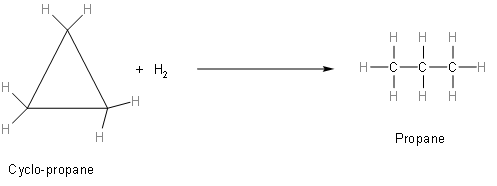
Consider the following two reactions:
i. Propene +${{H}_{2}}$→ Propane, $\Delta {{H}_{1}}$
ii. Cyclo-propane +${{H}_{2}}$→ Propane: $\Delta {{H}_{2}}$
Then, ΔH2−ΔH1 will be:
(A) 0
(B) $2{{(B.E)}_{C-C}}-{{(B.E)}_{C=C}}$
(C) ${{(B.E)}_{C=C}}$
(D) $2{{(B.E)}_{C=C}}-{{(B.E)}_{C-C}}$
Answer
121.2k+ views
Hint: First write down the reactions and their enthalpies in terms of bond energy. The energy for each type of bond is different, like B.E. for C-C, B.E. for C-H and B.E. for C=C will be different from each other but all C-H bonds will have the same bond energies. So, for each compound count the number of bonds for each type and write their enthalpies. Now subtract the enthalpies of both the reactions.
Complete step by step solution:
So, first of all, we have to write a reaction. And from that, we will find the number of bonds of different bond energy. The reaction of hydrogenation of propene and hydrogen is as follows.

The above reaction is the hydrogenation of propene into propane. Now we will write enthalpy in terms of bond energy.
\[\begin{align}
& \Delta {{H}_{1}}=\sum{(B.E}{{)}_{reac\tan ts}}-\sum{(B.E}{{)}_{products}} \\
& \Delta {{H}_{1}}=6{{(B.E)}_{C-H}}+{{(B.E)}_{C-C}}+{{(B.E)}_{C=C}}+{{(B.E)}_{H-H}} \\
& \,\,\,\,\,\,\,\,\,\,\,\,\,\,\,-8{{(B.E)}_{C-H}}-2{{(B.E)}_{C-C}} \\
\end{align}\]
From the above equation we can say that, 6 denotes the number of hydrogen single bonds, whereas, in propene there is one single C-C bond and one carbon double bond. Whereas, on the product side, we have eight carbon hydrogen single bonds and two carbon-carbon single bonds. Now, we will further simplify the above equation.
\[\,\,\Delta {{H}_{1}}\,\,\,={{(B.E)}_{C=C}}+{{(B.E)}_{H-H}}-{{(B.E)}_{C-H}}-{{(B.E)}_{C-C}}\]
So, the above equation represents the enthalpy of reaction in terms of bond energy.
Now, in the same way, we will write the equation of cyclo-propane.

The above figure represents the hydrogenation of cyclopropane into propane.
\[\begin{align}
& \Delta {{H}_{2}}=\sum{(B.E}{{)}_{reac\tan ts}}-\sum{(B.E}{{)}_{products}} \\
& \Delta {{H}_{2}}={{(B.E)}_{C-C}}-{{(B.E)}_{C-H}}+{{(B.E)}_{H-H}} \\
\end{align}\]
This above equation represents hydrogenation of cyclopropane.
Now, we should calculate the difference in enthalpy in terms of bond energy.
\[\Delta {{H}_{2}}-\,\Delta {{H}_{1}}\,={{(B.E)}_{C-C}}-{{(B.E)}_{C-H}}+{{(B.E)}_{H-H}}-{{(B.E)}_{C=C}}+{{(B.E)}_{H-H}}-{{(B.E)}_{C-H}}-(B.E)\]
\[\Delta {{H}_{2}}-\,\Delta {{H}_{1}}=2{{(B.E)}_{C-C}}-{{(B.E)}_{C=C}}\]
Now, we can say that option B is the correct answer.
Note: We should now know about bond energy. We should know that bond energy (E) is defined as the amount of energy, which is required to break apart a mole of molecules into its component atoms. It is a measure of the strength of a chemical bond. Bond energy is also known as bond enthalpy (H) or simply as bond strength.
Complete step by step solution:
So, first of all, we have to write a reaction. And from that, we will find the number of bonds of different bond energy. The reaction of hydrogenation of propene and hydrogen is as follows.

The above reaction is the hydrogenation of propene into propane. Now we will write enthalpy in terms of bond energy.
\[\begin{align}
& \Delta {{H}_{1}}=\sum{(B.E}{{)}_{reac\tan ts}}-\sum{(B.E}{{)}_{products}} \\
& \Delta {{H}_{1}}=6{{(B.E)}_{C-H}}+{{(B.E)}_{C-C}}+{{(B.E)}_{C=C}}+{{(B.E)}_{H-H}} \\
& \,\,\,\,\,\,\,\,\,\,\,\,\,\,\,-8{{(B.E)}_{C-H}}-2{{(B.E)}_{C-C}} \\
\end{align}\]
From the above equation we can say that, 6 denotes the number of hydrogen single bonds, whereas, in propene there is one single C-C bond and one carbon double bond. Whereas, on the product side, we have eight carbon hydrogen single bonds and two carbon-carbon single bonds. Now, we will further simplify the above equation.
\[\,\,\Delta {{H}_{1}}\,\,\,={{(B.E)}_{C=C}}+{{(B.E)}_{H-H}}-{{(B.E)}_{C-H}}-{{(B.E)}_{C-C}}\]
So, the above equation represents the enthalpy of reaction in terms of bond energy.
Now, in the same way, we will write the equation of cyclo-propane.

The above figure represents the hydrogenation of cyclopropane into propane.
\[\begin{align}
& \Delta {{H}_{2}}=\sum{(B.E}{{)}_{reac\tan ts}}-\sum{(B.E}{{)}_{products}} \\
& \Delta {{H}_{2}}={{(B.E)}_{C-C}}-{{(B.E)}_{C-H}}+{{(B.E)}_{H-H}} \\
\end{align}\]
This above equation represents hydrogenation of cyclopropane.
Now, we should calculate the difference in enthalpy in terms of bond energy.
\[\Delta {{H}_{2}}-\,\Delta {{H}_{1}}\,={{(B.E)}_{C-C}}-{{(B.E)}_{C-H}}+{{(B.E)}_{H-H}}-{{(B.E)}_{C=C}}+{{(B.E)}_{H-H}}-{{(B.E)}_{C-H}}-(B.E)\]
\[\Delta {{H}_{2}}-\,\Delta {{H}_{1}}=2{{(B.E)}_{C-C}}-{{(B.E)}_{C=C}}\]
Now, we can say that option B is the correct answer.
Note: We should now know about bond energy. We should know that bond energy (E) is defined as the amount of energy, which is required to break apart a mole of molecules into its component atoms. It is a measure of the strength of a chemical bond. Bond energy is also known as bond enthalpy (H) or simply as bond strength.
Recently Updated Pages
Types of Solutions - Solution in Chemistry

Difference Between Crystalline and Amorphous Solid

JEE Main Participating Colleges 2024 - A Complete List of Top Colleges

Sign up for JEE Main 2025 Live Classes - Vedantu

JEE Main 2025 Helpline Numbers - Center Contact, Phone Number, Address

JEE Main 2025 Exam Pattern: Marking Scheme, Syllabus

Trending doubts
JEE Main Chemistry Exam Pattern 2025

Collision - Important Concepts and Tips for JEE

JEE Mains 2025 Correction Window Date (Out) – Check Procedure and Fees Here!

Calculate CFSE of the following complex FeCN64 A 04Delta class 11 chemistry JEE_Main

Clemmenson and Wolff Kishner Reductions for JEE

JEE Main Course 2025: Get All the Relevant Details

Other Pages
JEE Advanced 2025: Dates, Registration, Syllabus, Eligibility Criteria and More

JEE Main 2022 June 25 Shift 2 Question Paper with Answer Keys & Solutions

JEE Main Maths Paper Pattern 2025

Electromagnetic Waves Chapter - Physics JEE Main

JEE Main 2022 June 27 Shift 2 Question Paper with Answer Keys & Solutions

NCERT Solutions for Class 11 Chemistry In Hindi Chapter 7 Equilibrium




